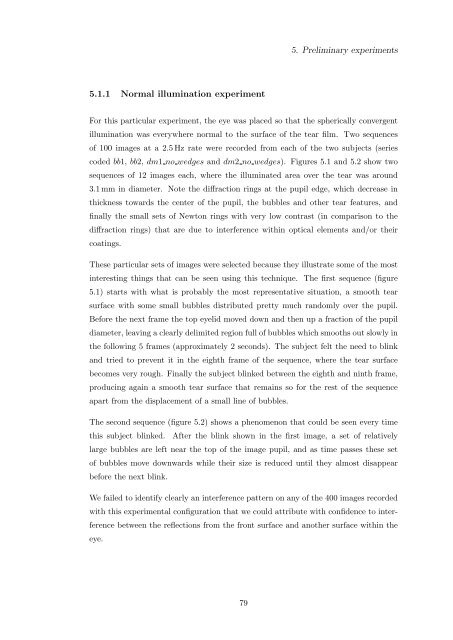Alfredo Dubra's PhD thesis - Imperial College London
Alfredo Dubra's PhD thesis - Imperial College London
Alfredo Dubra's PhD thesis - Imperial College London
You also want an ePaper? Increase the reach of your titles
YUMPU automatically turns print PDFs into web optimized ePapers that Google loves.
5. Preliminary experiments<br />
5.1.1 Normal illumination experiment<br />
For this particular experiment, the eye was placed so that the spherically convergent<br />
illumination was everywhere normal to the surface of the tear film. Two sequences<br />
of 100 images at a 2.5 Hz rate were recorded from each of the two subjects (series<br />
coded bb1, bb2, dm1 no wedges and dm2 no wedges). Figures 5.1 and 5.2 show two<br />
sequences of 12 images each, where the illuminated area over the tear was around<br />
3.1 mm in diameter. Note the diffraction rings at the pupil edge, which decrease in<br />
thickness towards the center of the pupil, the bubbles and other tear features, and<br />
finally the small sets of Newton rings with very low contrast (in comparison to the<br />
diffraction rings) that are due to interference within optical elements and/or their<br />
coatings.<br />
These particular sets of images were selected because they illustrate some of the most<br />
interesting things that can be seen using this technique. The first sequence (figure<br />
5.1) starts with what is probably the most representative situation, a smooth tear<br />
surface with some small bubbles distributed pretty much randomly over the pupil.<br />
Before the next frame the top eyelid moved down and then up a fraction of the pupil<br />
diameter, leaving a clearly delimited region full of bubbles which smooths out slowly in<br />
the following 5 frames (approximately 2 seconds). The subject felt the need to blink<br />
and tried to prevent it in the eighth frame of the sequence, where the tear surface<br />
becomes very rough. Finally the subject blinked between the eighth and ninth frame,<br />
producing again a smooth tear surface that remains so for the rest of the sequence<br />
apart from the displacement of a small line of bubbles.<br />
The second sequence (figure 5.2) shows a phenomenon that could be seen every time<br />
this subject blinked. After the blink shown in the first image, a set of relatively<br />
large bubbles are left near the top of the image pupil, and as time passes these set<br />
of bubbles move downwards while their size is reduced until they almost disappear<br />
before the next blink.<br />
We failed to identify clearly an interference pattern on any of the 400 images recorded<br />
with this experimental configuration that we could attribute with confidence to interference<br />
between the reflections from the front surface and another surface within the<br />
eye.<br />
79

















